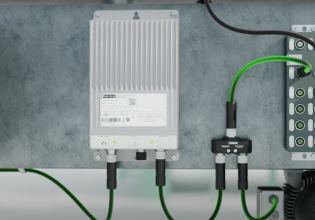Researchers Point to Ultrasonics and Microfluidics to Add Small-scale Capability to Robots
ETH Zürich has developed a method to move small amounts of fluid using ultrasonic energy, giving micro-scale robots untapped capabilities in and outside of the laboratory.
Researchers at Eidgenössische Technische Hochschule (ETH) Zürich have increased the capabilities of microscale robots through the use of piezoelectric transducers vibrated ultrasonically. In their experimental setup, a small, glass needle was vertically vibrated in a fluid at the end of a robotic arm, creating vortex patterns in the fluid and also allowing it to be pumped through small microfluidic channels, such as those found on lab-on-a-chip electronics.

The vibrations of a glass needle generate vortex patterns in the fluid around them. The frequency of the vibrations and container dimensions determine the locations of these patterns, and the amplitude determines the intensity. Image used courtesy of ETH Zürich
Ultrasonic Energy and a Piezoelectric Transducer
In this system, ultrasonic energy is generated using a piezoelectric transducer. Piezoelectric materials can generate a voltage when they are strained. They can also change shape slightly when a voltage is applied. This is analogous to how a microphone and a speaker are very similar devices. In a microphone, sound waves physically move a cone and a magnet past a coil, generating a small, varying current. A speaker receives a varying current, generating a magnetic field, which moves a magnet and cone to generate the sound wave.
The robotic system’s program generates the necessary signal that is sent to the piezoelectric transducer. This signal may change over time to perform different patterns or for different operations. The transducer will react to this signal and vibrate the needle.
Acoustofluidic End Effector—Potential Use Cases
So far, the ultrasonic system has been used to move suspended particles in a liquid and to pump small amounts of fluid through microchannels for various microfluidic experiments. Outside of the laboratory, there are many potential uses for such a system.
For biological and biochemical applications, the ultrasonic collection of particles could be used to remove contaminants, boost stirring rates for mixing operations and other such processes. Particles tend to collect at areas where standing waves occur, just like particles on a drumhead, or salt sprinkled onto a Chladni Plate.
Consider a reaction where two liquids are mixed, but then a solid precipitates out of the solution. Varying the oscillation frequency might speed up the stirring and mixing operation, followed by a steady frequency to collect the precipitates into easily extractable areas. Fine tuning this signal could speed up this reaction for small scale applications.

Patterns made from solid particles in a liquid, based on different ultrasonic vibrations. The center is where the needle impacts the liquid. Image used courtesy of ETH Zürich
Another possibility would be to use the ultrasonic signal as a tiny pump. A small biological sample (such as blood or saliva) could be forced through narrow channels of a chip, exposing it to a variety of sensors. The sensors could be used to detect certain markers, indicating the presence of a virus, oxygen level, insulin, or other metrics. While some of these are still in development, it is possible that in the near future, a drop of blood could be tested thousands of times for a virus, increasing the accuracy significantly.
A Case for the Small Scale
It’s easy to look at the scale of large, industrial machinery and see how a small change, scaled up, can make a major impact on the efficiency of a system. However, it is also important to see how applying a concept learned in the laboratory can make a major impact when scaled down. This ultrasonic system will probably not stir thousand gallon reaction vessels but may be used to clean contamination from pharmaceuticals or food additives on a very small scale.
The future of ultrasonics in microfluidics will likely occur at the small-scale sensor level, rather than in the large industrial scale. Even so, there are many opportunities to implement these systems as they are developed. The future may be “small” but it will be mighty.






